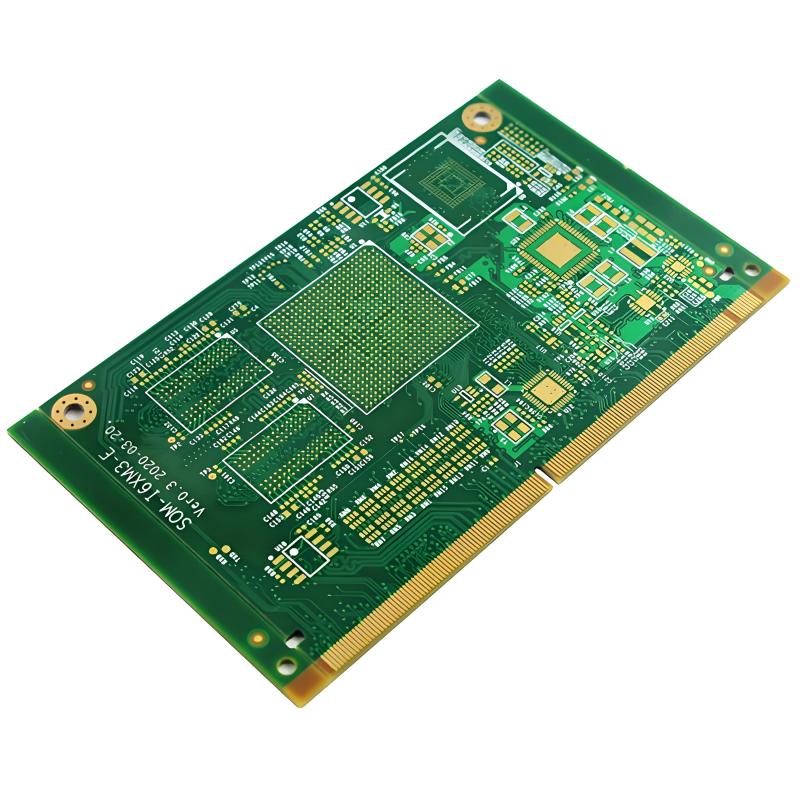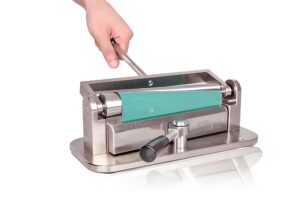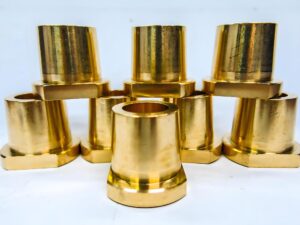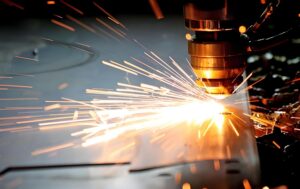What is Oxygen Free Copper?
Oxygen free copper (OFC) refers to a group of high-purity copper alloys that are carefully refined to reduce the oxygen content to very low levels. As the name implies, this copper undergoes a special manufacturing process that eliminates nearly all oxygen, resulting in copper with enhanced conductivity and superior quality.
The need for oxygen-free copper arose from industries that required extremely high conductivity and minimal signal loss, such as the electronics and aerospace sectors. Unlike conventional copper, which may contain up to 0.04% oxygen, oxygen free copper often contains less than 0.001% oxygen by weight.
OFC is valued not only for its electrical conductivity but also for its improved ductility, corrosion resistance, and overall performance in sensitive or high-performance applications. These qualities make it a material of choice for various precision components, including wires, connectors, and vacuum devices.
Chemical Composition of Oxygen Free Copper
The defining characteristic of oxygen free copper is, naturally, its incredibly low oxygen content. However, there’s more to the story. The chemical makeup of OFC must meet stringent standards to ensure both purity and performance.
Typically, oxygen free copper is composed of:
- Copper (Cu): 99.95% to 99.99%
- Oxygen (O): Less than 0.001% (often 5 ppm or less)
- Trace elements: May include silver (Ag), phosphorus (P), or other impurities in minute amounts, depending on the refining process.
Two common standards define the purity of oxygen free copper:
- C10100 (OFE – Oxygen-Free Electronic Copper): At least 99.99% Cu and 0.0005% oxygen max.
- C10200 (OF – Oxygen-Free Copper): At least 99.95% Cu and 0.001% oxygen max.
The exact composition depends on the intended application. For example, OFE copper is favored in vacuum electronics and high-vacuum environments due to its near-total absence of oxides and superior grain structure.
Properties of Oxygen Free Copper
Physical Properties
Oxygen free copper exhibits several notable physical characteristics that set it apart from standard copper grades:
- High Electrical Conductivity: OFC has electrical conductivity of up to 101% IACS (International Annealed Copper Standard), making it one of the best conductors available.
- High Thermal Conductivity: Excellent heat dissipation, ideal for high-power electronics and heat sinks.
- Density: Approximately 8.94 g/cm3
- Melting Point: Around 1,083°C (1,981°F)
- Color: Bright reddish hue, typical of high-purity copper
These physical properties make oxygen free copper a preferred material for high-performance applications, especially where heat and electrical flow are critical factors.
Mechanical Properties
In addition to superior conductivity, oxygen free copper also displays favorable mechanical traits:
- Tensile Strength: Between 220 MPa and 370 MPa depending on temper
- Yield Strength: Approximately 70 MPa to 250 MPa
- Elongation: Can range from 30% to 50%, showing excellent ductility
- Hardness: Typically between 40-60 HV (Vickers Hardness), depending on annealing
OFC can be easily machined, drawn, and welded. These mechanical properties make it highly adaptable in manufacturing processes such as CNC machining, forging, and extrusion.
What Are Types of Oxygen Free Copper Grades
Several grades of oxygen free copper are available to meet the demands of different industrial applications. The most common grades include:
C10100 Oxygen-Free Electronic Copper (OFE)
This is the highest purity grade of oxygen free copper and meets the stringent ASTM F68 standard. It has excellent thermal and electrical conductivity and is often used in high-vacuum systems, semiconductor manufacturing, and microwave devices.
C10200 Oxygen-Free Copper (OF)
While not as pure as C10100, C10200 still offers excellent conductivity and low oxygen content. It is more widely used in general electrical and electronic applications, including connectors, cables, and motor windings.
What Is Oxygen Free Copper Used For?

Oxygen free copper’s unique properties make it a go-to material in a wide range of industries. Its high conductivity and purity ensure it performs reliably in demanding environments. Some common applications include:
- Electronics and Electrical Engineering: OFC is widely used in electrical wiring, circuit boards, and connectors due to its superior conductivity. It’s a staple in high-performance electronics, where even minor signal loss can be detrimental.
- Audio and Video Equipment: High-end audio cables and speaker wires often use oxygen free copper to minimize signal distortion and deliver crystal-clear sound. Its low resistance ensures that audio signals remain pure, making it a favorite among audiophiles.
- Aerospace and Defense: In aerospace, OFC is used in components like radar systems, avionics, and satellite wiring, where reliability and performance are non-negotiable. Its corrosion resistance and durability make it ideal for harsh environments.
- Medical Devices: Oxygen free copper is found in medical imaging equipment, such as MRI machines, where its conductivity and purity ensure precise performance. Its biocompatibility also makes it suitable for certain medical applications.
- Industrial Applications: From heat exchangers to industrial furnaces, OFC’s thermal conductivity and resistance to high temperatures make it a versatile choice for industrial settings.
These applications highlight the material’s versatility, as it meets the needs of industries ranging from consumer electronics to heavy manufacturing.
Advantages and Disadvantages of Pure Copper
While oxygen free copper is a type of pure copper, it’s worth comparing its advantages and disadvantages to those of standard pure copper to understand its value.
Advantages of Oxygen Free Copper
- Superior Conductivity: OFC’s high purity ensures unmatched electrical and thermal conductivity, making it ideal for high-performance applications.
- Corrosion Resistance: The low oxygen content reduces the risk of oxidation, extending the material’s lifespan in challenging environments.
- Ductility and Workability: Its flexibility and ease of machining make it suitable for intricate designs and complex manufacturing processes.
- Reliability: The absence of impurities ensures consistent performance, critical in industries like aerospace and electronics.
Disadvantages of Oxygen Free Copper
- Higher Cost: The specialized refining process makes OFC more expensive than standard copper, which can be a limiting factor for budget-conscious projects.
- Limited Availability: Not all suppliers offer oxygen free copper, and certain grades, like C10100, may require specialized sourcing.
- Not Always Necessary: For applications where high purity isn’t critical, standard copper may suffice, making OFC an unnecessary expense.
In contrast, standard pure copper, while more affordable and widely available, may not offer the same level of performance in high-precision applications. Its higher oxygen content can lead to oxidation and reduced conductivity over time, making OFC the preferred choice for critical applications.
Why Oxygen Free Copper Matters in Modern Industry
Oxygen free copper’s role in modern industry cannot be overstated. Its ability to deliver reliable, high-quality performance in demanding applications makes it a cornerstone of innovation. From enabling faster, clearer communication in electronics to supporting cutting-edge aerospace technology, OFC is a material that drives progress.
For companies in the machining and manufacturing sectors, oxygen free copper offers a unique opportunity to create products that meet the highest standards of quality and performance. Its versatility allows it to be shaped, formed, and integrated into a wide range of components, from tiny circuit board traces to robust industrial parts.
As industries continue to push the boundaries of technology, the demand for high-purity materials like oxygen free copper will only grow. Its ability to meet the needs of both current and emerging applications ensures it remains a vital resource for manufacturers worldwide.
Why Choose Precionn for Oxygen Free Copper Machining?
For industries requiring the highest precision and performance in copper components, Precionn stands out as a trusted partner. With years of experience in the machining industry and a deep understanding of advanced materials like oxygen free copper, Precionn delivers unmatched quality in every product.
Whether you’re in aerospace, electronics, or high-end manufacturing, Precionn’s team ensures that every component meets stringent specifications and international standards. Through state-of-the-art equipment and rigorous quality control, Precionn is ready to serve the global market with excellence, reliability, and innovation.
Explore how Precionn can help bring your projects to life by visiting our official website or contacting our expert team for a consultation.




